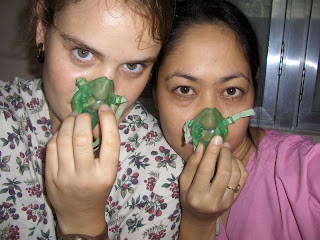My 111th birth handled.
My patient Rebecca, 17 y.o, G1P0 (means first pregnancy) came to the clinic on 4/09/00. I did an IE (internal examination) and she was 7cm open, 90% effaced, +1 station and intact Bag of Water. She was very quiet and handled her labor well.
Then after a while she wanted to push, so I did another IE to make sure she’s 10 cm so she can start pushing but she was already 8-9 cm. I lie down on the bed next to hers. I was about 5am in the morning she told me that she really wanted to push. She was almost 10cm. There was still an anterior cervical lip above the baby’s head. I let her breath and lie on her side. There should be no cervix above the baby’s head because it will be swollen with the pressure and it makes it harder for the baby’s head to come down.
After awhile she can’t helped but push so I pushed the anterior cervical lip up above the head of the baby so it will not come out together with the baby’s head. She was really a good pusher. After few times pushing her Bag of Water ruptured with slight meconium stain (meaning her baby already pooped inside which means the baby is already distressed). She was pushing for a while and there was only a little progress. So I let her on full squat then on birth stool.
Then the baby’s head was already visible and then after few pushes the head crowned with a caput formation. Then the head was out and was rotating 180 degrees. That was great! Usually, the baby’s head only rotates 90 degrees. The baby was out at 6:45am to a healthy baby girl named Jezelyn, with apgar score of 9/9, weighed 2523 grms/ 5.9 lbs. Glory to God.
The caput was huge found near in the frontal lobe. It means the baby’s was not properly position during the birth process. We immediately gave the baby a vitamin K to prevent bleeding. Usually we gave vitamin K after few hours after birth but in cases of huge caput we need to give it immediately. The baby was doing great.
The placenta was out at 7:00am but the membranes were not complete so we put the patient on methergine tabs. The patient has a labial laceration but no need of suturing. She only lost 100cc of estimated blood loss. I endorsed her to my co worker Sara Jones. Present at birth: Julie Tinio, Kristen Grubb, Lynn Jones.
1st stage- 20 hrs 08 mins
2nd stage- 46 mins
3rd stage- 6 mins
Admitted- 6 hrs.
에어컨으로 실내 습도 낮추는 방법 100% 가이드 (2025)
6 months ago








